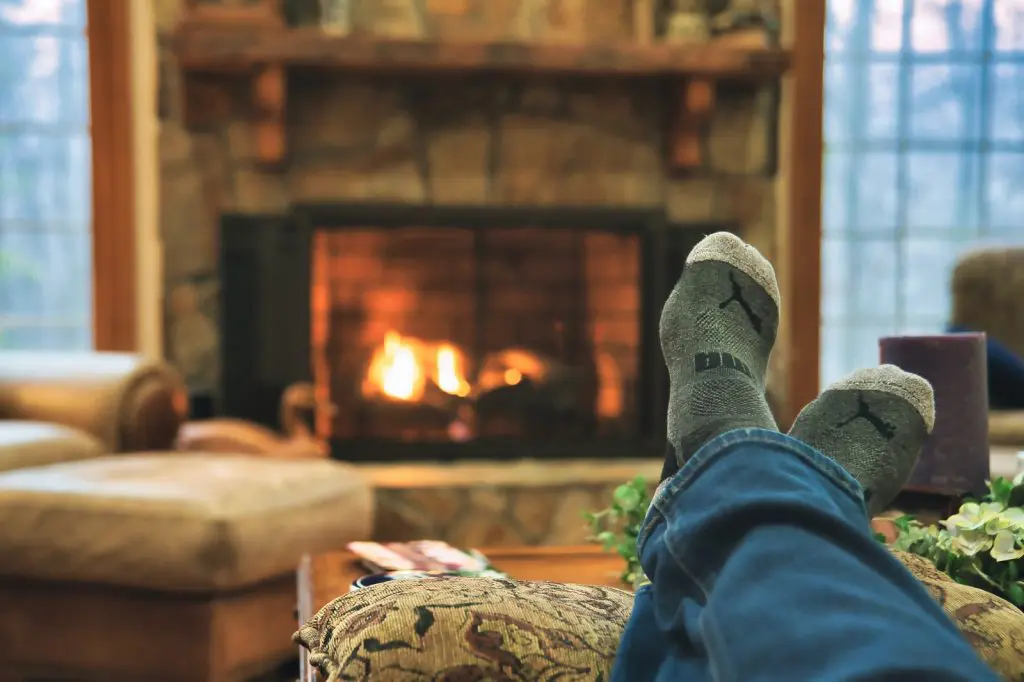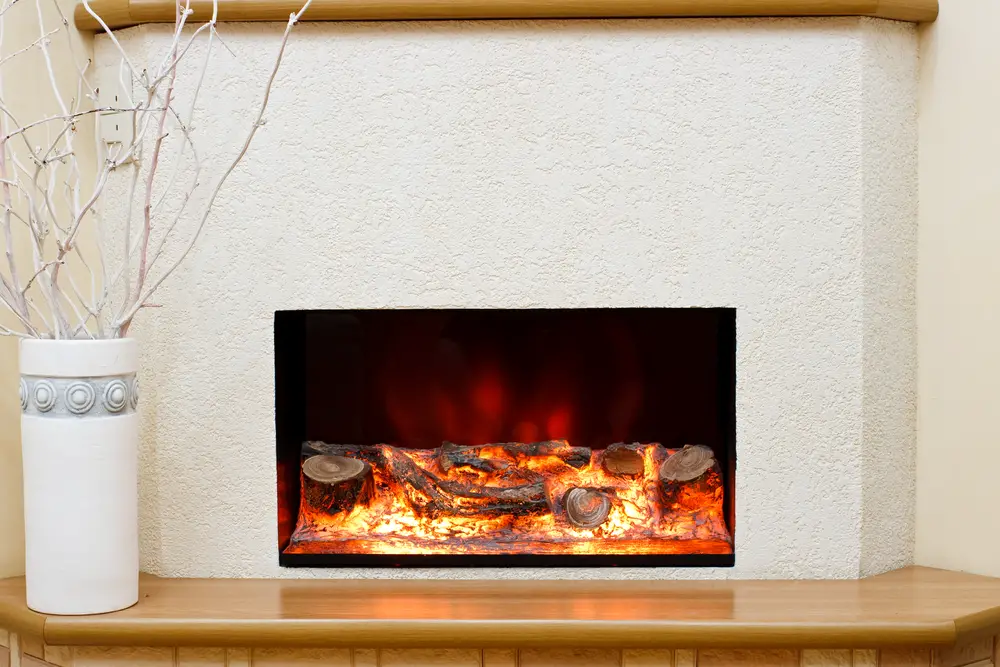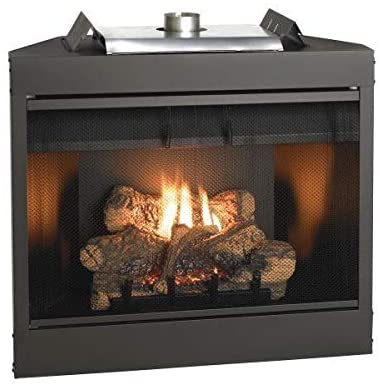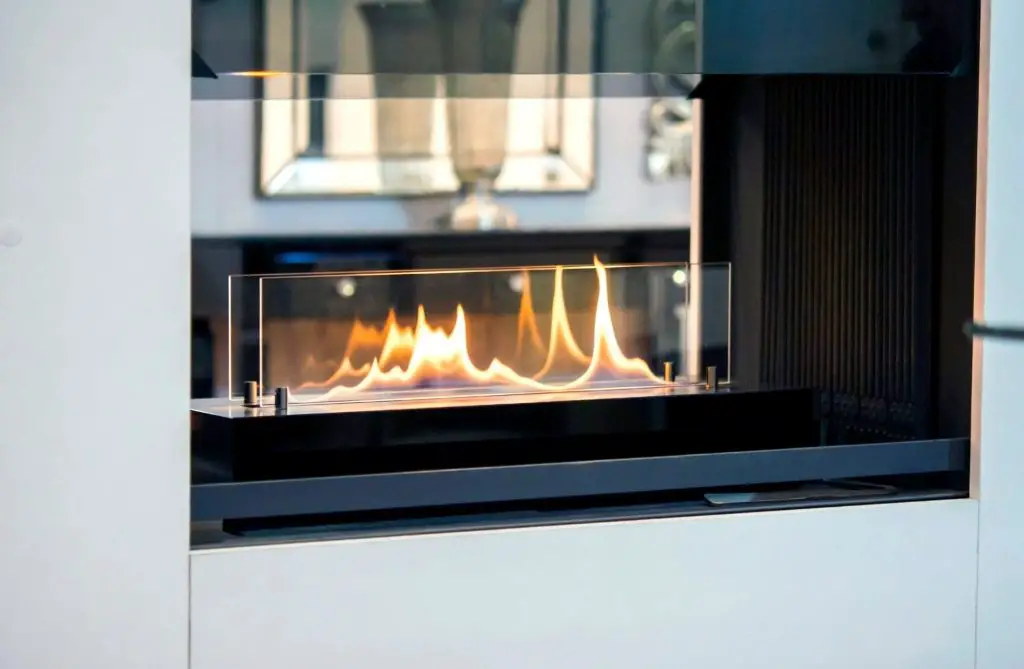Compared to traditional wood-burning fireplaces, ventless gas fireplaces provide many advantages. Compared to wood or vented gas fireplaces, they use less energy because they don’t have an exterior vent.
Contents
- What Are Ventless Gas Fireplaces?
- How Do Ventless Gas Fireplaces Work?
- Our Top Vent Free Pick
- What Types Of Ventless Gas Fireplaces Are Available?
- Built-In Ventless Gas Fireplaces
- 2-Sided Ventless Gas Fireplaces
- Outdoor Ventless Gas Fireplaces
- Inserts
- Are Ventless Gas Fireplaces Safe?
- Ventless Gas Fireplaces Vs. Other Types Of Fireplaces
- Wood-Burning Fireplaces
- Pros:
- Cons:
- Electric fireplaces
- Pros:
- Cons:
- Vented Gas Fireplaces
- Pros:
- Cons:
- Alcohol (Ethanol & Gel) Fireplaces
- Pros:
- Cons:
- Water Vapor Fireplaces
- Pros:
- Cons:
- There Advantages And Disadvantages Of Using A Ventless Gas Fireplace.
- Pros:
- Cons:
- Can Ventless Gas Fireplaces Be Installed Outdoors?
- How To Choose The Right Ventless Gas Fireplace
- Conclusion
What Are Ventless Gas Fireplaces?
Natural gas and propane are the fuel sources for ventless gas fireplaces. There is no chimney or flue need, which makes them ideal for newer homes and flats, which are generally constructed without thermal vents to save energy. They’re also less expensive and less complicated to set up than conventional fireplaces.
Ventless gas fireplaces may still heat a small house and provide that familiar, pleasant atmosphere, even if most people don’t use them as a primary heat source anymore.
Today, there is a large selection of ventless gas fireplaces to choose from. Large ones can serve as the room’s center point while more streamlined and tiny ones are also popular choices. A ventless gas fireplace is available in a variety of designs, from the conventional to the contemporary.
How Do Ventless Gas Fireplaces Work?
Unvented or vent-free fireplaces use a gas unit connected to a natural gas or propane line to operate. The installation must be completed by a licensed gas or plumbing contractor to meet the manufacturer’s specifications for heating capacity.
Anywhere with a supply line can have one of these fireplaces installed. Many modern types have automated ignition, which saves energy and money by eliminating the need for a standing pilot. In the event of a power outage, they can also be used in battery backup mode. A single ventless gas fireplace may be sufficient to heat your entire house, depending on its size.
Our Top Vent Free Pick
What Types Of Ventless Gas Fireplaces Are Available?
A wide variety of stunning ventless gas fireplaces are on the market today. You’ll be able to locate one that’s appropriate for your personal preferences. Due to the fact that ventless gas fireplaces must be linked to a gas line, expert installation is required for all of them.
- Built-In
- 2-Sided
- Outdoor
- Inserts
- Insertion of a Log
- Inserts made of modern glass
Built-In Ventless Gas Fireplaces
Many people like built-in fireplaces because of their sleek, modern aesthetic. Due to the fact that they are flush with the wall, there is nothing protruding. For a smooth, welcoming area, there are lined and unlined versions available so you can always select a style that matches your decor.
2-Sided Ventless Gas Fireplaces
Installing a 2-sided ventless gas fireplace in a shared wall allows you to enjoy the heat in two separate rooms. Because of their battery backup mode, our 2-Sided fireplaces may be utilized even when the power is out. Stainless steel frame sliders are an option from a number of manufacturers, so they may be fitted outside.
Outdoor Ventless Gas Fireplaces
We provide a wide selection of beautiful ventless gas fireplaces for both indoor and outdoor use. With their stainless steel frames, outdoor fireplaces not only look great, but they’re also quite durable.
Inserts
Ventless gas inserts are an excellent method to complete your fireplace’s look. Inserts can be divided into two categories: log-style inserts and contemporary glass inserts.
Insertion of a log:
- It has the appearance of a wood-burning fire.
- A traditional-style fireplace insert with all the benefits of modern technology.
- The upkeep and maintenance requirements are really low.
- Simple to set up
- Propane or natural gas can be used with this unit.
Inserts made of contemporary glass:
- There are numerous hues to choose from.
- Regular fire glass, reflective fire glass, fire gems, and rocks are just a few of the options available.
- Make your home or business look more up-to-date and colorful
- Propane or natural gas can be used with this unit.
Are Ventless Gas Fireplaces Safe?
Before being put on the market, all ventless gas fireplaces must pass stringent safety tests in laboratories.
There are built-in oxygen detection sensors (ODS) and carbon monoxide detectors (CO) in the majority of ventless gas fireplaces. Using the oxygen sensor, your fireplace will be immediately shut off if the oxygen level in the room falls dangerously low. If the CO detector detects any carbon monoxide, it will also turn off the fireplace.
Ventless Gas Fireplaces Vs. Other Types Of Fireplaces
Few things create a warm and welcoming ambiance faster than gathering around a fireplace as temperatures drop and leaves begin to fall. In order to help fireplace enthusiasts go through all of the choices, we’ve put together this quick guide.
Wood-Burning Fireplaces

Fireplaces that burn wood like traditional hearths, wood stoves, and pellet stoves, have been popular for centuries. Most of them have a firebox made of brick or metal and a chimney, while some types have a vent instead. They do, however, create smoke in contrast to ventless gas fireplaces.
Pros:
- Properly fueled fires last a long time.
- Wood chips and logs are readily available.
- The pleasant smell of a wood-burning fire
- They can be found in a lot of older houses.
Cons:
- As a result, they waste a significant amount of heat generated by the fire.
- They must be maintained on a regular basis to ensure their safety and effectiveness.
- The smoke and other pollutants emitted during the manufacturing process may be hazardous.
- Wood-burning fireplaces have been outlawed in several communities due to homeowner associations.
Electric fireplaces

Electric fireplaces, despite the fact that they don’t have a genuine flame, still offer a sense of coziness and warmth to your home. Some even allow you to customize the color of the electric flames to match your mood or the time of year. Ventless gas fireplaces, on the other hand, have a benefit over electric fireplaces in that they continue to operate even when the power is out.
Pros:
- They are easy to set up and transport from room to room.
- They don’t emit any odor or ash because they don’t use any fuel.
- Some versions have the ability to heat only a few square feet.
- Because there is no real flame, they are safe for pets and little children.
Cons:
- Your electricity bill may go up as a result of their use.
- In the event of a power outage, they are unable to offer heat or light.
Vented Gas Fireplaces

A gas line to a natural gas or propane reservoir is required for vented fireplaces, much like for ventless fireplaces. Due to the expensive cost of installing a chimney and vent, these fireplaces are better suited to homes that already have one.
Pros:
- Compared to other solid fuels, such timber logs, the cost of fuel is quite low.
- Depending on the size of your home, they may be able to provide adequate heat.
- Many various styles are on offer, so you’re sure to discover something that suits your preferences.
- The flame can be controlled remotely or continuously.
Cons:
- Because of the vent, they’re not as efficient as traditional wood-burning fireplaces.
- Regular inspections of chimneys and vents are required to keep them working properly.
- A venting system must be installed unless one already exists in your house.
Alcohol (Ethanol & Gel) Fireplaces

Due to its high content in water vapor and CO2, alcohol burns very cleanly and creates something comparable to human breath. Alcohol fireplaces, like ventless gas fireplaces, don’t need a chimney or a vent.
Unlike ventless gas fireplaces, however, alcohol fireplaces don’t have any gas lines, so they can be installed anywhere, although more fuel is required. Isopropyl alcohol and ethanol alcohol are the main ingredients of alcohol fireplace fuel, which is available in gel or liquid form.
Pros:
- Because alcohol burns cleanly, they are environmentally favorable.
- There is no need for a chimney or a vent for them.
- They are transportable due to the lack of a need for vents or gas lines.
- As a result, no ash or creosote is generated.
Cons:
- A bottle of booze costs more than a gallon of gas.
- Because alcohol doesn’t get as hot as gas, you’ll have to use more of it to heat your room.
- Compared to other fuels, alcohol gels and liquids are more difficult to come by.
Water Vapor Fireplaces
Water vapor (also known as steam) fireplaces, like ventless gas fireplaces, don’t require a chimney or a vent. They discharge a fine mist into the air with the help of only a few household items: tap water and power. A water vapor fireplace’s realistic flames are cool to the touch, making it ideal for homes with pets or small children.
Pros:
- The fact that they don’t need a vent means they can be placed almost anyplace.
- These fake flames are the most lifelike you’ll find.
- Pets, children, and commercial places can all enjoy the flames because they are cool to the touch.
- No hazardous pollutants are produced by water vapor fireplaces.
Cons:
- Because they are powered by electricity, they are unable to function when the power is out.
- Additional heat sources can’t be used because these don’t create any warmth.
There Advantages And Disadvantages Of Using A Ventless Gas Fireplace.
Due to their large heating capacity and lack of need for an electric pilot light, 20,000 BTU fireplaces are a great addition to your home during blackouts because they can warm up to 1,200 square feet.
However, there are a few disadvantages to ventless gas fireplaces that you should be aware of before making the purchase. Below, we’ll go over the good and bad points.
Pros:
- Chimneys are up to 99 percent efficient since no heat is lost via them.
- As long as you choose for an optional $150 annual checkup, they require almost little upkeep.
- It’s possible to use them both indoors and out.
- No ash or creosote is produced by ventless gas fireplaces.
- Oxygen and carbon monoxide sensors are now standard on most modern models.
Cons:
- Gas fumes might cause severe reactions in certain persons.
- Using a ventless gas fireplace has been outlawed in some states and localities
- Refills for a gas ventless fireplace can be very expensive.
- Due to the fact that gas burns hot, it may not be appropriate for usage in tiny areas.
Can Ventless Gas Fireplaces Be Installed Outdoors?
Yes, it is possible to install a ventless gas fireplace outside. Several of our units are strong enough to be installed outside and are weather-resistant.
Adding an outdoor fireplace enhances the ambiance of your room and extends the comforts of inside living to the great outdoors. The classic wood-burning outdoor fireplaces, which many homeowners associations have barred owing to environmental concerns, are not only more expensive but also more difficult to build.
How To Choose The Right Ventless Gas Fireplace
- If you’re thinking of getting a ventless gas fireplace, ask yourself these questions first.
- Your new fireplace will be installed in a specific location, right? Is this in the family room? Outdoors? Is it in your personal space? If you’re considering installing a ventless gas fireplace in a smaller room, such as a bedroom or a bathroom, make sure your state’s regulations allow it first.
- Want to be able to keep your house warm even if there’s a blackout? Find out how much energy you’ll need to heat your home by consulting recommended BTU recommendations per square foot.
- You’re renovating a prefab house, or are you building a new house and putting a fireplace? These aspects can assist you in making a decision on the location- especially if you want to be able to turn your gas fireplace on/off with a wall switch.
- How much of an area do you have outside for a fireplace? If this is the case, you have a wide range of choices to choose from. If that’s the case, keep trying. Installing a half-inside, half-outside ventless gas fireplace is an option.
- What’s the design of your house like? Are you on the lookout for something cutting-edge yet not overly flashy? Alternatively, do you favor more classic styles that rely on small elements like a mantel to create visual weight? A home that reflects your personal style is easier to maintain and more comfortable to live in.
• What is the size of your area? A huge fireplace might not be the greatest choice if your rooms are small or if you have a specific decorating style. As an example, a low-profile fireplace with a slender profile may not look as good against a large wall.
• Last but not least, how much money do you have to work with? Gas fireplaces with vented flues are a cost-effective option, but some are more expensive than others. Your dream fireplace is within reach if you follow the steps in this guide and keep your expenses low at the same time.
Conclusion
Ventless gas fireplaces are an excellent addition to any home because of their low cost and high efficiency. When compared to typical wood-burning fireplaces, ventless gas fireplaces are a far better option because they produce less waste and smoke while also heating your home more efficiently.
Modern fireplaces come equipped with carbon monoxide and oxygen monitors that shut down your fireplace if the air quality in the room deteriorates or if the carbon levels rise above the naturally occurring traces. It’s safe to use a ventless gas fireplace since it has to comply with federal standards before it’s allowed on the market.







